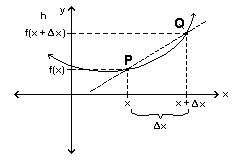Limit Definition of the Derivative
The geometric meaning of the derivative
is the slope of the line tangent to y = f(x) at x.
Let's look for this slope at P:
The secant line through P and Q has slope
f(x+Δx)-f(x)
(x+Δx)-x
|
= |
f(x+Δx)-f(x)
Δx
|
. |
|

|
We can approximate the tangent line through P by moving Q
towards P, decreasing Δx. In the limit as Δx→
0, we get the tangent line through P with slope
lim
Δx→ 0
|
f(x+Δx)-f(x)
Δx
|
. |
We define
| f′(x) = |
lim
Δx→ 0
|
f(x+Δx)-f(x)
Δx
|
. |
|
|
|
If the limit as Δx → 0 at a particular
point does not exist, f′(x) is undefined
at that point. |
|
We derive all the basic differentiation formulas using this
definition.
Example
For f(x) = x2,
|
|
= |
|
|
= |
lim
Δx→ 0
|
(x2+2(Δx)x+Δx2)-x2
Δx
|
|
|
= |
|
|
= |
|
|
= |
2x |
as expected.
Example
For f(x) = 1/x
again as expected.
Notes
The limit definition of the derivative is used to prove many
well-known results, including the following:
-
If f is differentiable at x0, then f is continuous at
x0. [ma sarebbe più sensato definire la derivata direttamente solo per le funzioni continue]
-
Differentiation of polynomials.
-
Product and Quotient Rules for differentiation.
Si usano anche altre notazioni:
• D(f) al posto di f'
• D(f)(x) o Dx((f(x)) o (f(x))'x al posto di f'(x)
Key Concepts [index]
We define
| f′(x) = |
lim
Δx→ 0
|
f(x+Δx)-f(x)
Δx
|
. |
|
